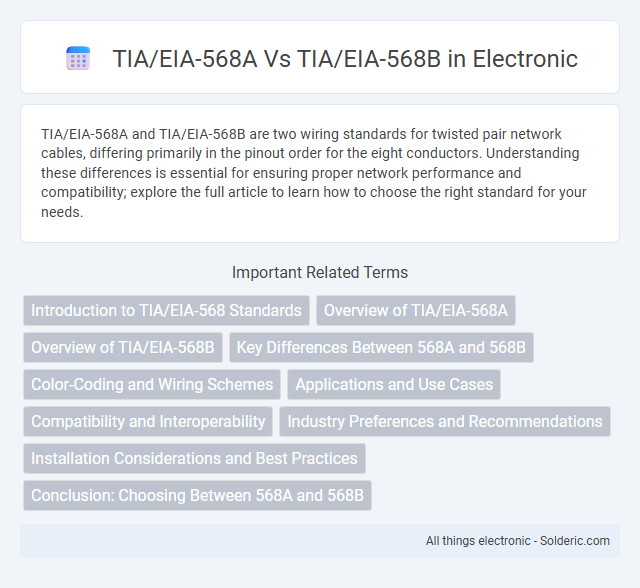TIA/EIA-568A and TIA/EIA-568B are two wiring standards for twisted pair network cables, differing primarily in the pinout order for the eight conductors. Understanding these differences is essential for ensuring proper network performance and compatibility; explore the full article to learn how to choose the right standard for your needs.
Comparison Table
| Feature | TIA/EIA-568A | TIA/EIA-568B |
|---|---|---|
| Standard Purpose | Preferred for new installations, especially in government projects | Widely used in commercial installations and older setups |
| Wiring Color Code | Green pair: pins 1 & 2; Orange pair: pins 3 & 6 | Orange pair: pins 1 & 2; Green pair: pins 3 & 6 |
| Pin 1 & 2 Functions | Transmit data | Transmit data |
| Pin 3 & 6 Functions | Receive data | Receive data |
| Compatibility | Compatible with older telephone installations | More common in Ethernet networks |
| Usage | Used in IT and telecommunication for balanced twisted-pair cabling | Used primarily for Ethernet network cabling |
| Standard Reference | ANSI/TIA/EIA-568A | ANSI/TIA/EIA-568B |
Introduction to TIA/EIA-568 Standards
The TIA/EIA-568 standards define structured cabling systems for commercial buildings to ensure reliable data transmission and interoperability. TIA/EIA-568A and TIA/EIA-568B specify different wiring color codes and pin assignments for terminating twisted-pair Ethernet cables, such as Cat5e and Cat6. Understanding these standards is essential for network technicians to maintain consistency and compatibility in network installations.
Overview of TIA/EIA-568A
TIA/EIA-568A is a telecommunications standard developed by the Telecommunications Industry Association that defines the wiring scheme for twisted pair cabling in structured cabling systems. It specifies the pinout assignments and color codes for 8-position, 8-conductor (8P8C) connectors commonly used in Ethernet networking. The TIA/EIA-568A standard emphasizes backward compatibility with earlier wiring schemes and is widely utilized in residential and commercial network installations.
Overview of TIA/EIA-568B
TIA/EIA-568B is the most widely adopted wiring standard for Ethernet cabling, defining pinout configurations for terminating twisted pair cables such as Cat5e and Cat6. It specifies the color coding and order of the eight wires, ensuring proper connectivity and reliable performance in network installations. Understanding TIA/EIA-568B is essential for your network's compatibility, as most commercial and residential systems follow this standard to maintain interoperability.
Key Differences Between 568A and 568B
TIA/EIA-568A and TIA/EIA-568B differ primarily in the wiring order for the twisted pairs within the Ethernet cable, with 568A assigning green pairs to pins 1 and 2, while 568B uses orange pairs for those pins. These standards impact network performance and compatibility, as incorrect pairing can lead to crosstalk and reduced data transmission quality. Understanding your network requirements and ensuring consistent use of either 568A or 568B throughout your infrastructure is crucial for optimal connectivity and minimized troubleshooting.
Color-Coding and Wiring Schemes
TIA/EIA-568A and TIA/EIA-568B differ primarily in their color-coding and wiring schemes for twisted-pair Ethernet cables. Both standards define pinouts for 8P8C connectors, but TIA/EIA-568A uses a green pair as the primary transmit and receive wires, while TIA/EIA-568B uses an orange pair for the same purpose. Choosing the correct wiring scheme ensures compatibility and optimal performance for Your network installations.
Applications and Use Cases
TIA/EIA-568A and TIA/EIA-568B are wiring standards primarily used in twisted-pair Ethernet cabling for structured cabling systems. TIA/EIA-568A is often preferred in government and residential installations due to its backward compatibility with older telephone wiring schemes, while TIA/EIA-568B is more common in commercial environments and widely adopted for gigabit Ethernet deployments. Your choice between the two standards affects network consistency, compatibility, and ease of troubleshooting in different use case scenarios.
Compatibility and Interoperability
TIA/EIA-568A and TIA/EIA-568B wiring standards ensure compatibility and interoperability by using the same pinouts for data transmission, enabling devices within a network to communicate effectively regardless of the variant used. The key difference lies in the color coding of the pairs, which means mixed use within the same network requires careful adherence to a single standard on both ends to prevent wiring mismatches and signal issues. Your network performance remains reliable when connectors and cables follow consistent TIA/EIA-568 standards, facilitating seamless integration across various hardware.
Industry Preferences and Recommendations
TIA/EIA-568A and TIA/EIA-568B are two wiring standards for Ethernet cables, with 568B being more widely adopted across industries due to its compatibility with existing telecommunication systems. Your choice between the two should consider regional preferences and specific network compatibility requirements, as 568B tends to dominate in commercial installations. Industry recommendations often favor 568B for new projects because it aligns better with modern infrastructure and equipment manufacturers' guidelines.
Installation Considerations and Best Practices
TIA/EIA-568A and TIA/EIA-568B define wiring standards for twisted-pair cabling, with 568B more commonly used in new installations due to its widespread adoption. When installing, maintaining consistent wiring schemes at both ends ensures proper signal transmission and reduces crosstalk or interference. Your best practice includes testing cable continuity and adhering to manufacturer specifications to guarantee network performance and reliability.
Conclusion: Choosing Between 568A and 568B
Choosing between TIA/EIA-568A and TIA/EIA-568B depends on existing infrastructure and regional preferences, with 568A commonly used in government installations and residential settings, while 568B dominates commercial environments in the United States. Both standards provide reliable and consistent wiring schemes for Category 5/5e/6 cables, ensuring proper network performance when properly implemented. Ensuring compatibility within the same wiring standard across all connected devices minimizes potential connectivity issues and simplifies maintenance.
TIA/EIA-568A vs TIA/EIA-568B Infographic

 solderic.com
solderic.com